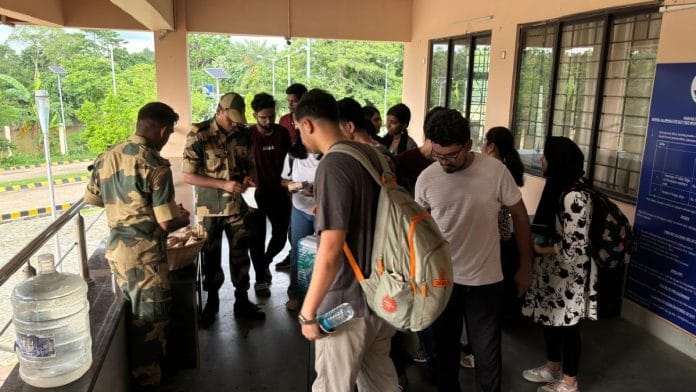New Delhi: Deployed along the India-Bangladesh border in Tripura, a Border Security Force (BSF) jawan received an SOS from a friend, a Punjab-based doctor whose son, along with 35 other Indian students, was stuck in the Brahmanbaria Medical College in eastern Bangladesh.
With internet services snapped across the country in light of student-led protests against the Sheikh Hasina government’s stand on the freedom fighter quota, the MBBS students were unable to communicate with their parents.
It was against this backdrop that the SOS put out by the BSF jawan’s friend led to the rescue of nearly 500 students, including Nepalese and Bhutanese nationals, at first from Bangladesh via checkposts along the border in Tripura.
Till Tuesday evening, a total of 4,315 students from India, Nepal, Bhutan, the Maldives and Canada — including 41 from Bangladesh — entered India between 18 and 23 July through checkposts along the border in West Bengal, Assam, Meghalaya, Tripura and Mizoram.
According to data collated by the Eastern Command of the BSF, as many as 3,087 of them were Indians followed by 1,118 from Nepal, 66 from Bhutan, and 41 from Bangladesh.
Additionally, the BSF also facilitated movement of one Canadian student and a few Maldivian students.
BSF officials told ThePrint that as soon as the Inspector General (IG) of the force’s Tripura Frontier was alerted about the SOS, he set up a communications channel with counterparts in Border Guard Bangladesh to ensure the return of students stuck in Brahmanbaria Medical College.
But, the operation ran into two challenges: communication with BGB nodal officers was not smooth owing to internet restrictions; and reluctance of BGB officials who maintained that the unrest would soon end.
The BGB, at the BSF IG’s insistence, sought the assistance of local police and administration by the wee hours of Saturday to ensure safe passage for the students. Later that day, 59 students including 36 of the Brahmanbaria Medical College entered India through the Akhaura border crossing.
By Monday afternoon, at least 167 more students entered India through the same route. Of the 15 who entered India Monday, 11 were from Dhaka’s Sirajul Islam Medical College, while four were from the Community Based Medical College in Bangladesh’s capital city.
Additionally, 493 students entered India from Comilla through the Srimantapur integrated check post between Saturday and Monday.
“Comilla is just four-five km from Srimantapur and the city has three medical colleges with a high number of foreign MBBS students,” a BSF official said.
“Initially these students were sent in buses and ambulances provided by their respective hospital administrations which were moving under police protection until being handed over to the BGB. The BGB facilitated their passage to the international border where we had set up our 24*7 immigration desk to ensure a smooth influx of students,” a BSF official said.
Another added, “The rescue operation was closely monitored and supervised by officials in the Indian High Commission in Dhaka who helped keep the communication channel intact; we were getting alerts on time about schedule of arrival of students in batches.”
Data maintained by the BSF’s South Bengal Frontier shows that a total of 1,157 Indian students made their way back to India from Bangladesh between 18 and 22 July, with 479 coming through Mahadipur Land Customs Station (LCS) and 351 through Gede LCS.
Besides these two entry points, students also entered India through Ghojadanga LCS and the integrated check post at Petrapole.
“Communication channels between the two border-guarding forces have been activated to ensure a well-planned and coordinated operation. Demonstrating mutual cooperation, BGB safely escorted the students to the international border, after which BSF took over their care and further transportation,” said BSF South Bengal Frontier spokesperson DIG A.K. Arya.
Data also shows that nearly half of all students who entered India through the Tripura Frontier belong to Jammu and Kashmir (170), followed by Tamil Nadu (77) and West Bengal (72).
“The current law and order situation in Bangladesh due to the anti-reservation protest poses security challenges and implications for BSF also as Tripura is a bordering state covered on all sides by Bangladesh. One of the prime concerns right now is the safe return of Indian students studying there,” BSF IG and in-charge of Tripura Frontier HQ Piyush Purushottam Das Patel said.
“As you are aware, the number of Indian students in Bangladesh is believed to be close to 8,000. Most of the students studying in medical colleges in Comilla, Brahmanbaria and Dhaka chose to enter into India through four ICPs/LCS, especially through Agartala in West Tripura district and Srimantapur in Sepahijala district,” he added.
(Edited by Amrtansh Arora)
Also Read: Bangladesh Supreme Court cuts down controversial quota. Here’s why country’s hit by violent protests






